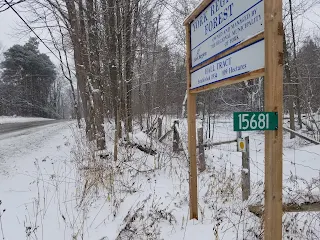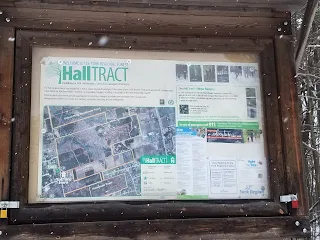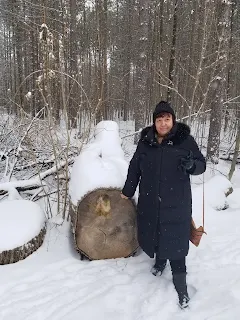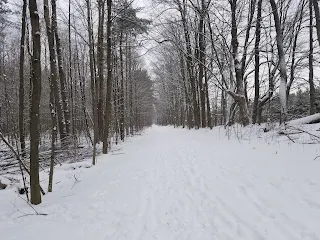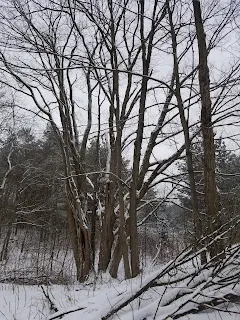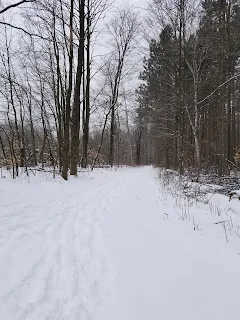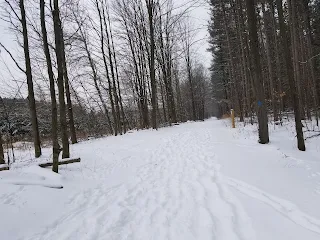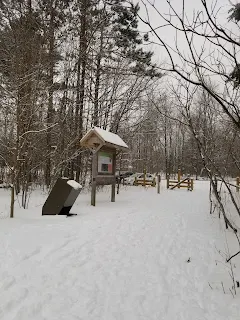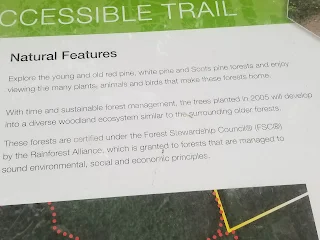Address 15681 McCowan Road Whitchurch-Stouffville, Ontario Canada
Large parking lot is available that is well maintained during winter, so people can use the parking lot while waking in the forest.
Hall Tract was established in 1934 and has 109 hectares. Is owned and managed by York Region.
York Regional Forest was established in 1924 to restore degraded landscapes. It has grown to 2200 hectares (5400 ) acres.
The Oak Ridges Moraine Foundation (ORMF) is a non-profit organization based in Newmarket, Ontario, Canada. It was founded in 2002 as a governing body dedicated to the enhancement and preservation of the Oak Ridges Moraine as a healthy and vibrant ecosystem. It is more than 90 per cent privately owned, and supports related agricultural, industrial, commercial and recreational uses.
Since established in 2002 the ORMF has distributed in excess of $14 million in grants to 177 projects and leveraged, in collaboration with Moraine partners, an additional $35.8 million for Moraine-related projects. Of the money distributed 41 per cent was dedicated to land securement, 37 per cent to stewardship, 12 per cent to public education, 7 per cent to the expansion of the Oak Ridges Trail, and 3 per cent to research.
The Oak Ridges Moraine Foundation (ORMF) is a non-profit organization based in Newmarket, Ontario, Canada. It was founded in 2002 as a governing body dedicated to the enhancement and preservation of the Oak Ridges Moraine as a healthy and vibrant ecosystem. It is more than 90 per cent privately owned, and supports related agricultural, industrial, commercial and recreational uses.
Since established in 2002 the ORMF has distributed in excess of $14 million in grants to 177 projects and leveraged, in collaboration with Moraine partners, an additional $35.8 million for Moraine-related projects. Of the money distributed 41 per cent was dedicated to land securement, 37 per cent to stewardship, 12 per cent to public education, 7 per cent to the expansion of the Oak Ridges Trail, and 3 per cent to research.
These forests provide opportunities for recreation , ecological restoration and " Sustainable forest management" which include tree planting trail development very good initiatives but also harvesting which is devastating for the forest.
In 2004 York Region and Oak Ridges Moraine foundation acquired the agricultural lands south of the Hall Tract to expand the Regional Forest. From 2005 to 2008 tree seedling were planted and now a new forest with trees exceeding 2 meter height thrives.
If more people would visit the Tract we might be able to create a movement where the public opinion would stop these agencies that are logging in the forest to stop. The majority of the trees in the forest were very young and large number of trees were cut.
They would be better used for eco therapy; there’s scientific evidence supporting eco-therapy.
Forest bathing—basically just being in the presence of trees—became part of a national public health program in Japan in 1982 when the forestry ministry coined the phrase shinrin-yoku and promoted topiary as therapy. Nature appreciation—picnicking en masse under the cherry blossoms, for example—is a national pastime in Japan, so forest bathing quickly took. The environment’s wisdom has long been evident to the culture: Japan’s Zen masters asked: If a tree falls in the forest and no one hears, does it make a sound?
To discover the answer, masters do nothing, and gain illumination. Forest bathing works similarly: Just be with trees. No hiking, no counting steps on a Fitbit. You can sit or meander, but the point is to relax rather than accomplish anything.
From 2004 to 2012, Japanese officials spent about $4 million dollars studying the physiological and psychological effects of forest bathing, designating 48 therapy trails based on the results.
Qing Li, a professor at Nippon Medical School in Tokyo, measured the activity of human natural killer (NK) cells in the immune system before and after exposure to the woods.
Large parking lot well maintained during the winter.
Good walking space for dogs and people.
Beautiful view of the tract with tall but thin trees.
Here you see the devastation of the forest.
How old were these tree?
They could have lived in the forest better that to be transformed in flyers.
Few older trees remained.
This forest was a plantation . York Region proudly affirm that only 30% from the initial forest is still standing. The rest was used for timber. We would like to change that. We want to preserve and conserve the nature instead of "manage" it. Who is using the money ? Those that manage it? We prefer the trees.
Here are more logging. The forest is an ecosystem. The ecosystem is suffering when the trees are cut. They provide house for animals and birds.
Here is the newly bought land that has a new plantation.
Industrial use of the forest. It is not ok. We need to preserve it.
Old trees are on the sidewalk. That was the enlargement of the road. and part of the 50 million of tax dollars spent.
From 2004 to 2012, Japanese officials spent about $4 million dollars studying the physiological and psychological effects of forest bathing, designating 48 therapy trails based on the results.
Qing Li, a professor at Nippon Medical School in Tokyo, measured the activity of human natural killer (NK) cells in the immune system before and after exposure to the woods.
Li’s subjects showed significant increases in NK cell activity in the week after a forest visit, and positive effects lasted a month following each weekend in the woods.
This is due to various essential oils, generally called phytoncide, found in wood, plants, and some fruit and vegetables, which trees emit to protect themselves from germs and insects. Forest air doesn’t just feel fresher and better—inhaling phytoncide seems to actually improve immune system function.
Forest environments promote lower concentrations of cortisol, lower pulse rate, lower blood pressure, greater parasympathetic nerve activity, and lower sympathetic nerve activity than do city environments.
Trees soothe the spirit too. A study on forest bathing’s psychological effects surveyed 498 healthy volunteers, twice in a forest and twice in control environments. The subjects showed significantly reduced hostility and depression scores, coupled with increased liveliness, after exposure to trees. “Accordingly,” the researchers wrote, “forest environments can be viewed as therapeutic landscapes.”
Preservation versus Conservation
Here is another story about the forest and people that we can use as example for the Canadian Forests; John Muir a Scottish naturalist and preservationist , inventor (1838-1914) also known as "John of the Mountains" and "Father of the National Parks".
During his time "forestry was tree farming," as is in Canada in 2017.
Muir valued nature for its spiritual and transcendental qualities. In one essay about the National Parks, he referred to them as "places for rest, inspiration, and prayers." He often encouraged city dwellers to experience nature for its spiritual nourishment.
In later years he turned more seriously to writing, publishing 300 articles and 10 major books that recounted his travels, expounded his naturalist philosophy. Muir's love of the high country gave his writings a spiritual quality. His readers, whether they be presidents, congressmen, or plain folks, were inspired and often moved to action by the enthusiasm of Muir's own unbounded love of nature.
In 1890, due in large part to the efforts of Muir, an act of Congress created Yosemite National Park. Muir was also personally involved in the creation of Sequoia , Mount Rainier , Petrified Forest and Grand Canyon national parks. Muir deservedly is often called the "Father of the National Park System " in USA.
He invited Roosevelt to meet with him in
1903 as part of Roosevelt's Western tour, which included Yosemite, Yellowstone, and the Grand
Canyon, among other scenic areas. The two camped overnight in the Yosemite back country,
talking late into the night about the need for federal oversight of the valley. Roosevelt was
deeply affected by the experience; in a speech in Sacramento, California immediately following
his Yosemite visit, he declared, "Lying out at night under those giant Sequoias was like lying in a
temple built by no hand of man, a temple grander than any human architect could by any
possibility build, and I hope for the preservation of the groves of giant trees simply because it
would be a shame to our civilization to let them disappear.
What made Theodore Roosevelt a conservationist hero was his conviction that pelicans, 2,000-year-old redwood trees and ancient rock formations belonged to future generations of Americans as well as to the past. , Roosevelt saved over 234 million acres of wild America.
In Canada government is renting the forest to foreigner and domestic companies such as Japanese companies that are logging also in National Parks for timber that they export.
It is time for a paradigm shift from management to conservation and plantation of new forests. Implementation of permaculture would be an asset, and private ownership of the forests free of taxes with the only condition to preserve and maintain the tree and eventually to plant more.
Large parking lot well maintained during the winter.
Good walking space for dogs and people.
Beautiful view of the tract with tall but thin trees.
Here you see the devastation of the forest.
How old were these tree?
They could have lived in the forest better that to be transformed in flyers.
Few older trees remained.
This forest was a plantation . York Region proudly affirm that only 30% from the initial forest is still standing. The rest was used for timber. We would like to change that. We want to preserve and conserve the nature instead of "manage" it. Who is using the money ? Those that manage it? We prefer the trees.
Here are more logging. The forest is an ecosystem. The ecosystem is suffering when the trees are cut. They provide house for animals and birds.
Here is the newly bought land that has a new plantation.
Industrial use of the forest. It is not ok. We need to preserve it.
Old trees are on the sidewalk. That was the enlargement of the road. and part of the 50 million of tax dollars spent.



